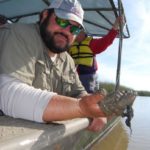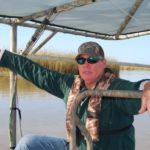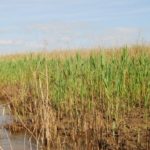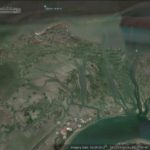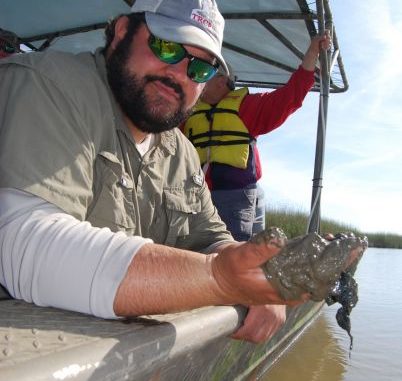
Four such diversions included in state’s coastal master plan, Macaluso says
BURAS, LA. – When Capt. Ryan Lambert started guiding 35 years ago, the habitat on the west side of the Mississippi River at Buras was much different than it is today.
“Back when I started fishing here, you would have to navigate your way to the Gulf of Mexico,” said Lambert, who operates Cajun Fishing Adventures on Highway 23. “Now you can turn your wheel that way and never touch it again and not touch a piece of land. It’s all gone”
With the land loss, Lambert said many of the fish, birds and animals that lived on the west side of the river are no longer there.
“The worst thing is the habitat is gone. There’s nowhere for the fish to escape predation, so everything in the larval stage gets eaten,” he said. “The other problem is there’s no habitat for wildlife anymore. There’s no ducks on that side, except for divers. There’s no coons, otters and mink. There’s not nutrias or other fur-bearing animals.
“It’s devoid of life — all the bird life is gone. It’s a dead zone.”
The plight of the west side sits in stark contrast to the thriving habitat on the east side of the Mississippi, where Lambert recently conducted a mudboat tour to show how sediment diversions are actually creating new land and a thriving ecosystem.
Separated by only the width of the river, the west and east sides couldn’t appear more different to even the most-casual observer.
“Just going across the river where the freshwater is meeting the saltwater, it’s a wildlife wonderland,” Lambert said.”It’s an incredible sight to see because everywhere you look and every second you look, there’s some kind of bird or animal.
“You can’t go anywhere without seeing wildlife, and that’s the difference between what’s happening on the west and what’s happening on the east.”
Proponents of sediment diversions, like Chris Macaluso of the Theodore Roosevelt Conservation Partnership, believe using the power of the Mississippi River to create new land with the massive sediment load it carries downstream will be a big key to rebuilding Southeast Louisiana’s coast.
“The west side doesn’t really have any natural or man-made connection to the river. There’s Davis Pond far up in the Barataria Basin, and that’s a freshwater diversion really to control salinity,” Macaluso said. “But you don’t have cuts in the levee, you don’t have crevasses and diversions on the west side, and the consequence of that is you don’t get any more sediment in there. And so that land has continued to subside, and as it subsides, it erodes. We see that reflected in the maps.
“If you look at the difference of the west side of the river, say in the 1960s, and what you see now in 2015, most of those bays and lakes are just gone.”
Four sediment diversions — two on the east side of the river and two on the west side — are currently included in the state’s coastal master plan, Macaluso said.
The one farthest along in the engineering and design phase is the Mid-Barataria Diversion out of Myrtle Grove, which is being funded in part by settlements paid by BP and Transocean in connection with the 2010 Deepwater Horizon oil spill.
“Most of Louisiana’s problem at this point is subsidence,” Macaluso said. “It’s a sediment-starved system. In the areas where we’re experiencing the majority of our land loss, it’s starved for sediment.
“When you put sediment back in the system, it has benefit. We see that even when we dredge sediment and place it.”
One advantage of sediment diversions is the river continually builds the system and makes it self-sustainable, Lambert said.
“When you pump sediment and take that pump away, it starts deteriorating. Versus when you have a diversion and a terrace project, it just keeps growing and growing and growing as long as you feed it,” Lambert said. “It’s building habitat — not just land, but habitat.
“If you pump sand, you build a sandbar, and it’s going to grow some grass on that sandbar, but that’s still all you’ve got.”
Contrary to what many sediment diversion opponents believe, Macaluso said they don’t create “blowouts” where freshwater from the river enters the saltwater system.
“When you have a diversion or cut or channel open up, generally what happens at first is the water flow comes through and it will scour a hole, and it will scour out a channel and dig it a little deeper,” Macaluso said. “But then the sides of that channel will start to shallow up. As they shallow and you establish a new platform, you’ll get some vegetation growth on that, and as you continue to get more and more flood cycles — as the water and suspended sediment load comes up in the springtime and that water spills out over the flats and the vegetation has been established in the shallow water area — it slows that water down and allows the sediments to fall out.
“As you continue to build land through that process, you get new layers of sediment that form on top of that land year after year, and you get new layers of vegetation that form year after year, and you start building that land higher and higher, and that delta continues to move its way farther and farther way from that water source.”
The key for Macaluso now is educating the public on what the river is capable of doing for the coast — year in and year out.
“We have an amazingly productive estuary here, in comparison to what they have in other parts of the Gulf in terms of the number of fish, shrimp, oysters and crabs that we can produce and the number of waterfowl we can overwinter. That’s because of the river, not in spite of it,” he said. “But what’s happened is we’ve seen that production decline in certain parts of the state, and a lot of that decline I think can be attributed to the fact we’ve lost so much habitat because we’ve lost that connection with what the river established.
“The real take-home message here in coastal Louisiana is this is an amazingly productive system, a lot of people love to come here and hunt and fish, and it’s disappearing faster than anywhere else in the world — and we have an opportunity to slow down that disappearance and make the system sustainable.
“We just need to be able to have the political and social will to make those wise investments.”
Lambert has a standing offer for both supporters of sediment diversions — as well as those dead-set against the idea — to take a tour of the river system with him out of Buras.
“Anybody that’s concerned about what diversions will do, come get in a boat with me and make a list of all your concerns,” he said. “I don’t need to argue with you or convince you — just come in my boat with your list, and I’ll take you from spot to spot to spot and let you judge for yourself whether it’s fictitious or not.
“That’s all I ask. Just come get in my boat. I can take 10 people at a time. Bring a punch list of everything you think is going to happen. And everybody who has come in my boat has been completely changed.They can see the truth for themselves. They don’t need to take the word of a fear monger or someone who has self-interests in mind. They can see for themselves.”
